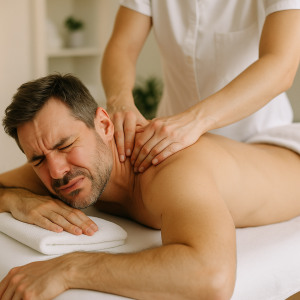 In a world where pain is often managed with a prescription pad, more people are asking: Is there a better way? One promising alternative is massage therapy. It’s non-invasive, generally safe, and, for many, surprisingly effective. Techniques like Reiki Massage also offer a gentle, energy-focused approach that some find helpful for managing discomfort. But can massage really reduce the need for pain medication? Let’s take a closer, clinical look.
In a world where pain is often managed with a prescription pad, more people are asking: Is there a better way? One promising alternative is massage therapy. It’s non-invasive, generally safe, and, for many, surprisingly effective. Techniques like Reiki Massage also offer a gentle, energy-focused approach that some find helpful for managing discomfort. But can massage really reduce the need for pain medication? Let’s take a closer, clinical look.
The State of Pain Management
According to the CDC, about 20% of U.S. adults live with chronic pain. The usual response? Medication—often opioids, NSAIDs, or muscle relaxants. While these can offer relief, they come with risks. Opioids, in particular, carry the risk of addiction, tolerance, and side effects like drowsiness, constipation, and slowed breathing. Even over-the-counter options aren’t harmless—long-term NSAID use can lead to stomach issues, kidney damage, or increased risk of heart problems.
This reality has pushed clinicians and patients alike to seek safer, complementary treatments. Massage therapy is one of the top contenders.
What Massage Actually Does
Massage therapy isn’t just about relaxation, though that’s a bonus. Clinically, massage affects both the body and the brain. Physically, it helps release muscle tension, improves circulation, and can increase range of motion. Neurologically, it activates the parasympathetic nervous system—the “rest and digest” mode—which counteracts the stress response and can reduce pain perception.
Massage may also trigger the release of endorphins, serotonin, and dopamine—natural chemicals that can ease discomfort and improve mood. This cocktail of effects can lead to a genuine reduction in pain experience, mainly when used regularly.
Clinical Evidence
There’s a growing body of research supporting massage therapy as a legitimate part of pain management. 2016 meta-analysis published in Pain Physician found that massage therapy reduced both pain and anxiety in surgical patients, leading to decreased use of opioid painkillers in the recovery phase.
In cases of chronic pain, such as in patients with arthritis or chronic lower back pain, massage has shown similar promise.
A Complement, Not a Cure-All
That said, massage isn’t a magic bullet. It doesn’t “replace” medication in every case. For acute injuries, severe inflammation, or post-operative care, medication may still be necessary—at least short-term. But massage can reduce the amount of medication needed or delay the need for higher doses. For people concerned about side effects or dependency, that’s a win.
Additionally, massage is most effective when used as part of a comprehensive strategy. Pain management is rarely one-size-fits-all. Physical therapy, exercise, psychological support, and lifestyle changes often work in tandem. Massage adds another tool to that toolbox.
Access and Practical Concerns
Despite its benefits, massage therapy isn’t always accessible. Insurance coverage is inconsistent. Many plans don’t cover it unless it’s prescribed or delivered by a licensed provider in a clinical setting. That limits access for people without discretionary income or flexible spending accounts.
There’s also variation in provider training and quality. Licensed massage therapists (LMTs) undergo standardized education and certification, but not all practitioners are equally skilled in clinical or therapeutic massage. If massage is to be taken seriously in medical contexts, better integration with healthcare systems and more straightforward clinical guidelines would help.
The Bottom Line
So, can massage reduce the need for pain medication? Clinically speaking, yes—especially for certain types of chronic or post-surgical pain. It’s not a replacement for every patient or every condition. However, it’s a safe and often effective option that deserves more attention from both healthcare providers and patients.
More research is needed, particularly regarding dosage (the frequency of massage required for optimal results), long-term effects, and cost-benefit analyses. But the current evidence is promising.
If you’re managing chronic pain and looking for alternatives to medication, massage therapy is worth a conversation with your healthcare provider. It might not replace your pain medication entirely, but it could help you use less—and feel better while doing so.

